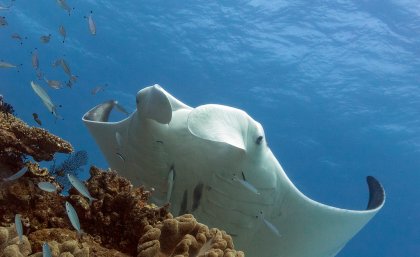 by Dr Kathy Townsend, Moreton Bay Research Station.jpg?itok=90aIIwam)
A University of Queensland scientist is calling for volunteer divers to photograph the underside of manta rays in waters off the Western Australian coastline and upload them to Facebook as part of a research project.
The photographs will be used as data in Project Manta, a research project to help track and protect two endangered species of manta ray in Australian and Indonesian waters.
School of Biomedical Sciences fish biologist Professor Mike Bennett said UQ students would be visiting fishing ports between Perth and Broome in October and November to recruit volunteers.
“Photographs taken by citizen scientists will provide us with vital information,” Professor Bennett said.
“The underside of a manta ray is highly patterned and, as each one is unique, this enables us to identify individuals and to monitor their movements.
“Details obtained from observational data will be entered into our database and will provide invaluable information for our manta ray protection research project.”
People interested in taking part should contact project.manta@uq.edu.au or visit Project Manta on Facebook.
The three-year research project is focused on two species of manta ray, the reef manta and giant manta, which are currently endangered by a worldwide increase in fishing activity.
Professor Bennett said the fieldwork would mostly take place in Western Australian, Northern Queensland, Northern Territory and Indonesian waters.
“We need a greater understanding of manta ray population dynamics to enable us to provide comprehensive population management and protection recommendations,” Professor Bennett said.
“These are very large fish. The giant manta grows to about seven metres from wing-tip to wing-tip, and we estimate they live in excess of 25 years.
“But their reproductive output is very low. We know the female gestation period is about one year and they seem to produce only one pup every three years.
“The manta rays’ ability to offset losses to their population due to fishing is therefore a real issue.”
The WA fieldwork is part of a three-year research project funded by a $315,000 Australian Research Council Linkage grant to develop a protection program for endangered manta ray species in Australian and Indonesian waters.
The ARC project brings together industry partners (Austral Fisheries, TG Kailis Marine Conservation Fund, Ningaloo Marine Interactions, Lady Elliot Island Eco Resort and Earthwatch Institute) and scientists from The University of Queensland, Murdoch University and Deakin University to explore the biology and ecology of manta rays in a research program that has attracted more than $1.5 million in funding.
Media: Professor Mike Bennett, +61 3365 2705, m.bennett@uq.edu.au; Lynda Flower, School of Biomedical Sciences, +61 3365 1536, l.flower@uq.edu.au
.jpg)









